Fife
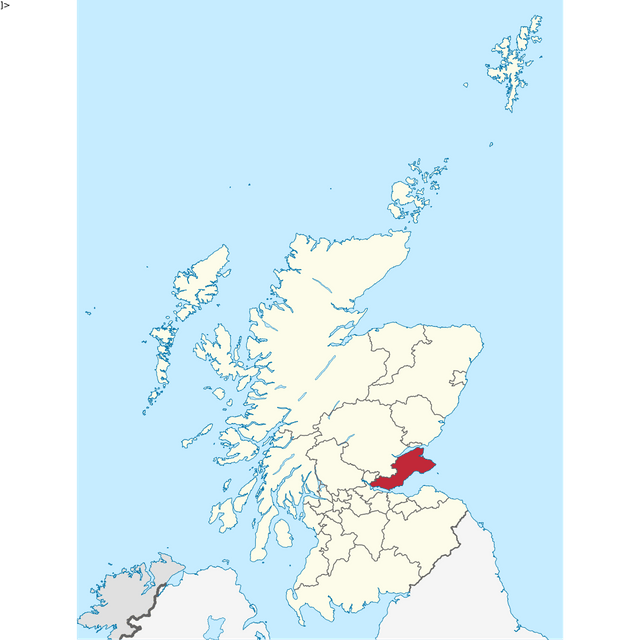
Fife

| Coordinates: | |
| Admin HQ | Glenrothes(formerlyCupar)[1] |
|---|---|
| Government | |
| • Body | Fife Council |
| • Control | SNP |
| •MPs | Douglas ChapmanStephen GethinsPeter GrantLesley Laird |
| •MSPs | Annabelle EwingJenny GilruthWillie RennieShirley-Anne SomervilleDavid Torrance |
| Area | |
| • Total | 512 sq mi (1,325 km) |
| Area rank | Ranked 13th |
| Population | |
| • Total | 371,400 |
| • Rank | Ranked 3rd |
| • Density | 700/sq mi (280/km) |
| ONS code | S12000015 |
| ISO 3166 code | GB-FIF |
| Website | |
Fife (/faɪf/, Scottish English: [fɐi̯f]; Scottish Gaelic: Fìobha; Scots: Fife) is a council area and historic county of Scotland. It is situated between the Firth of Tay and the Firth of Forth, with inland boundaries to Perth and Kinross (i.e. the historic counties of Perthshire and Kinross-shire) and Clackmannanshire. By custom it is widely held to have been one of the major Pictish kingdoms, known as Fib, and is still commonly known as the Kingdom of Fife within Scotland. Fife is one of the six local authorities part of the Edinburgh and South East Scotland city region.
It is a lieutenancy area, and was a county of Scotland until 1975. It was very occasionally known by the anglicisation Fifeshire in old documents and maps compiled by English cartographers and authors. A person from Fife is known as a Fifer.
Fife was a local government region divided into three districts: Dunfermline, Kirkcaldy and North-East Fife. Since 1996 the functions of the district councils have been exercised by the unitary Fife Council.
Fife is Scotland's third largest local authority area by population. It has a resident population of just under 367,000, over a third of whom live in the three principal towns of Dunfermline, Kirkcaldy and Glenrothes.
The historic town of St Andrews is located on the northeast coast of Fife. It is well known for the University of St Andrews, one of the most ancient universities in the world and is renowned as the home of golf.
| Coordinates: | |
| Admin HQ | Glenrothes(formerlyCupar)[1] |
|---|---|
| Government | |
| • Body | Fife Council |
| • Control | SNP |
| •MPs | Douglas ChapmanStephen GethinsPeter GrantLesley Laird |
| •MSPs | Annabelle EwingJenny GilruthWillie RennieShirley-Anne SomervilleDavid Torrance |
| Area | |
| • Total | 512 sq mi (1,325 km) |
| Area rank | Ranked 13th |
| Population | |
| • Total | 371,400 |
| • Rank | Ranked 3rd |
| • Density | 700/sq mi (280/km) |
| ONS code | S12000015 |
| ISO 3166 code | GB-FIF |
| Website | |
History
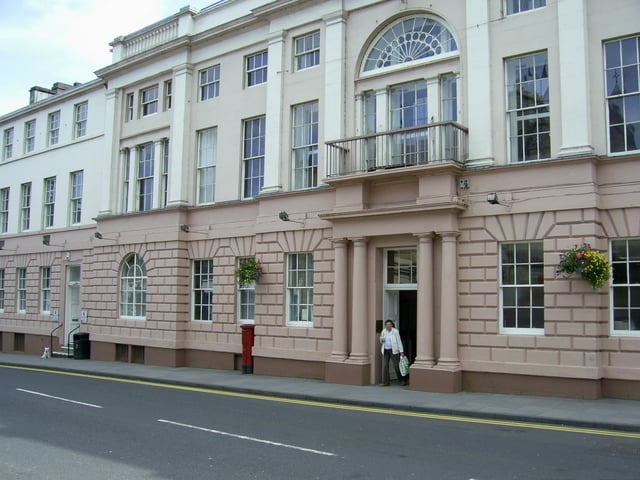
The historical headquarters of Fife County Council, in Cupar
Fife, bounded to the north by the Firth of Tay and to the south by the Firth of Forth, is a natural peninsula whose political boundaries have changed little over the ages. The Pictish king list and De Situ Albanie documents of the Poppleton manuscript mention the division of the Pictish realm into seven sub-kingdoms or provinces, one being Fife, though this is now regarded as a medieval invention.[2]The%20Place-N]][] The earliest known reference to the common epithet ife[2]Wyntoun[2]The%20Place-N]][] The name is recorded as in A.D. 1150 and ted with Fothriff.
Fife was an important royal and political centre from the reign of King Malcolm III onwards, as the leaders of Scotland gradually moved southwards away from their ancient strongholds around Scone. Malcolm had his principal home in Dunfermline and his wife Margaret was the main benefactor of Dunfermline Abbey. The Abbey replaced Iona as the final resting place of Scotland's royal elite, with Robert I amongst those to be buried there.
The Earl of Fife was until the 15th century considered the principal peer of the Scottish realm, and was reserved the right of crowning the nation's monarchs, reflecting the prestige of the area.
A new royal palace was gradually constructed at Falkland, formerly the stronghold of Clan MacDuff, and was used by successive monarchs of the House of Stuart, who favoured Fife for its rich hunting grounds.
King James VI of Scotland described Fife as a "beggar's mantle fringed wi gowd",[5] the golden fringe being the coast and its chain of little ports with their thriving fishing fleets and rich trading links with the Low Countries. Wool, linen, coal and salt were all traded. Salt pans heated by local coal were a feature of the Fife coast in the past. The distinctive red clay pan tiles seen on many old buildings in Fife arrived as ballast on trading boats and replaced the previously thatched roofs.
In 1598, King James VI employed a group of 12 men from Fife, who became known as the Fife adventurers, to colonise the Isle of Lewis in an attempt to begin the "civilisation" and de-gaelicisation of the region. This endeavour lasted until 1609 when the colonists, having been opposed by the native population, were bought out by Kenneth Mackenzie, the clan chief of the Mackenzies.
Fife became a centre of heavy industry in the 19th century.
Coal had been mined in the area since at least the 12th century, but the number of pits increased ten-fold as demand for coal grew in the Victorian period.
Previously rural villages such as Cowdenbeath rapidly swelled into towns as thousands moved to Fife to find work in its mines. The opening of the Forth and Tay rail bridges linked Fife with Dundee and Edinburgh and allowed the rapid transport of goods. Modern ports were constructed at Methil, Burntisland and Rosyth. Kirkcaldy became the world centre for the production of linoleum. Postwar Fife saw the development of Scotland's second new town, Glenrothes. Originally to be based around a coal mine, the town eventually attracted a high number of modern Silicon Glen companies to the region. Fife Council and Fife Constabulary also centre their operations in Glenrothes.
There are numerous notable historical buildings in Fife, some of which are managed by the National Trust for Scotland or Historic Scotland. They include Dunfermline Abbey (the last resting place of Scottish royalty), the palace in Culross, Ravenscraig Castle in Kirkcaldy, Dysart Harbour area, Balgonie Castle near Coaltown of Balgonie, Falkland Palace (hunting palace of the Scottish Kings), Kellie Castle near Pittenweem, Hill of Tarvit (a historical house), St. Andrews Castle, St. Andrews Cathedral and St. Rule's Tower.
Governance

Fife House, seat of Fife Council
Fife is represented by five constituency members of the Scottish Parliament (MSPs) and four members of the United Kingdom parliament (MPs) who are sent to Holyrood and the British Parliament respectively. Following the 2015 general election, all four of the MPs constituencies were held by the Scottish National Party.[6] In the 2017 general election, Kirkcaldy and Cowdenbeath was regained by Labour.[7] At the same election, the seat of North East Fife became the closest seat in the country with the SNP holding a majority of 2 over the Liberal Democrats[8] Three of the Scottish Parliament constituencies are held by the Scottish National Party: Cowdenbeath, Dunfermline, and Mid Fife and Glenrothes. One is held by the Scottish Liberal Democrats: North East Fife.[9]
Fife Council's administrative headquarters and Police Scotland's P Division (formerly Fife Constabulary) are based in Glenrothes. The Council meetings take place in Fife House (formerly known as Glenrothes House) in the town centre. The west wing of the building was built by the Glenrothes Development Corporation (GDC) as their offices in 1969, which was later used as the headquarters of Fife Regional Council.[10] The former administrative seat was Cupar.[1] Since the last Scottish election in 2012, Fife Council has been run as a minority by the Labour party, with a total of 35 seats, with support of Tory and independent councillors. Alex Rowley was elected leader of Fife Council but demitted office following his election as an MSP. David Ross succeeded as leader in February 2014. The SNP and the other parties form the opposition.
Geography
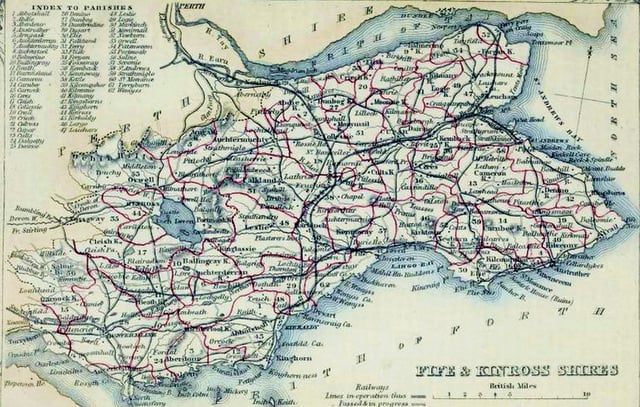
Fifeshire & Kinross-shire Civil Parish map,[11] with parishes outlined in red
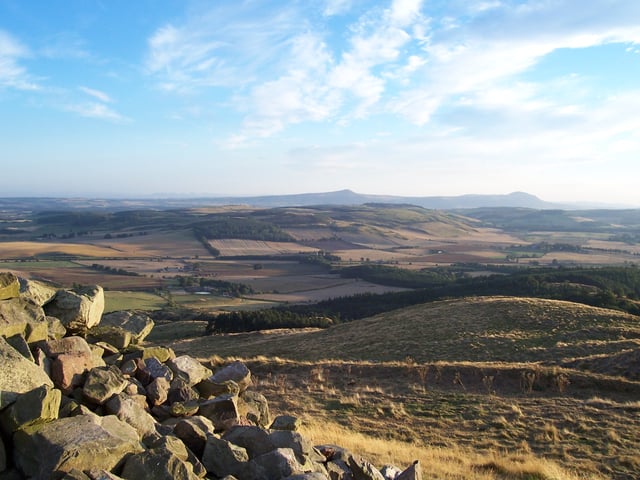
Looking across the farmland of North East Fife to the distant Lomond Hills
Fife is a peninsula in eastern Scotland bordered on the north by the Firth of Tay, on the east by the North Sea and by the Firth of Forth to the south. The route to the west is partially blocked by the mass of the Ochil Hills. Almost all road traffic into and out of Fife has to pass over one of four bridges, south on the Forth Road Bridge (public transport and cyclists only) and Queensferry Crossing, west on the Kincardine Bridge or north-east via the Tay Road Bridge, the exception being traffic headed north on the M90. Tolls were abolished on the Tay Road Bridge and Forth Road Bridge on 11 February 2008.
There are extinct volcanic features, such as the Lomond Hills which rise above rolling farmland, and Largo Law, a volcanic plug in the east. At 522 metres (1,713 ft), the West Lomond is the highest point in Fife. The coast has fine but small harbours, from the industrial docks in Burntisland and Rosyth to the fishing villages of the East Neuk such as Anstruther and Pittenweem. The large area of flat land to the north of the Lomond Hills, through which the River Eden flows, is known as the Howe of Fife.
North of the Lomond Hills can be found villages and small towns in a primarily agricultural landscape.
The areas in the south and west of Fife, including the towns of Dunfermline, Glenrothes, Kirkcaldy and the Levenmouth region are lightly industrial and more densely populated. The only areas which could claim to be heavily industrial are Rosyth, around the naval dockyard and perhaps the Mossmorran Natural Gas Liquids fractionation plant on the outskirts of Cowdenbeath.
The east corner of Fife, generally that east of a line between Leven and St Andrews is recognised throughout Scotland as the East Neuk (or corner) of Fife, small settlements around sheltered harbours, with distinctive vernacular "Dutch" or corbie (crow) stepped gabled and stone-built architecture – an area much sought after as second homes of the Edinburgh professional classes since the Forth Road Bridge was built. The fishing industry on which the East Neuk settlements were built has declined in recent years with the main fishing fleet now operating from Pittenweem and the harbour in Anstruther being used as a marina for pleasure craft.
There are several islands located off the coast of Fife, such as the Isle of May, Inchkeith and Inchcolm. The former Preston Island south of Valleyfield is no longer an island following land reclamation work.
Towns and villages
Cupar took over as county town from Crail in the early 13th century. Glenrothes is now the administrative centre, after the decision to locate the headquarters of the newly established Fife Regional Council there in 1975. Fife's three major towns are Kirkcaldy, Dunfermline and Glenrothes. According to the 2012 estimate, Dunfermline is the largest settlement by population,[12] followed by Kirkcaldy then Glenrothes. The next most sizeable towns by population are St Andrews, Cowdenbeath, Rosyth, Methil and Dalgety Bay. The rest of Fife includes smaller towns such as Inverkeithing, Kincardine, Anstruther, Lochgelly, Burntisland, Leven, Newburgh, Tayport and Cupar, and villages such as Springfield, Kinglassie, Kinghorn, Elie, Auchtertool, Crossgates, Ballingry and Auchtermuchty.
The county was formerly divided into parishes, often but not always based on a town or village:
Abbotshall
Abdie
Aberdour
Anstruther Easter
Anstruther Wester
Arngask (Perthshire)
Auchterderran
Auchtermuchty
Auchtertool
Ballingry
Balmerino
Beath
Buckhaven
Burntisland
Cameron
Carnbee
Carnock
Cellardyke
Ceres
Collessie
Cowdenbeath
Crail
Creich
Crossgates
Culross (Perthshire)
Cults
Cupar
Dairsie
Dalgety
Dunbog
Dunfermline
Dunino
Dysart
Elie
Falkland
Ferry Port on Craig
Flisk
Forgan
Freuchie
Glenrothes
Inverkeithing & Rosyth
Kelty
Kemback
Kennoway
Kilconquhar
Kilmany
Kilrenny
Kinghorn
Kinglassie
Kingsbarns
Kingskettle
Kirkcaldy
Ladybank
Largo
Leslie
Leuchars
Leven
Lochgelly
Logie
Lumphinnans
Markinch
Methil
Monimail
Moonzie
Newburgh
Newburn
Pitlessie
Pittenweem
Saline
Scoonie
St Andrews & St Leonards
St Monance (and Abercrombie)
Strathmiglo
Thornton
Torryburn
Wellwood
Wemyss
Culture

Falkland Palace

Scottish Lowlands farm. Detail from Slezer's Prospect of Dunfermline, 1693
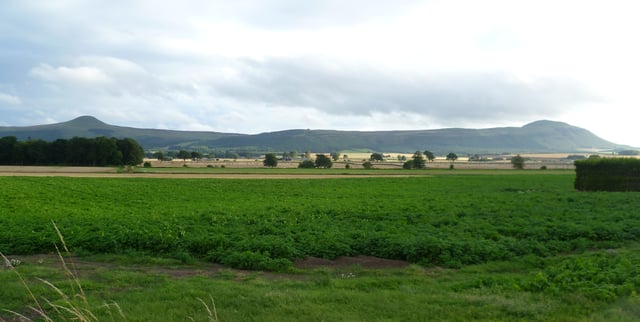
A closer view of the Lomond Hills, seen from Auchtermuchty
Fife contains 4,961 listed buildings and 48 conservation areas.[13] Domestic sites of importance include Falkland Palace, Kellie Castle, Dunfermline Palace, St Andrews Castle, Culross Palace and Kirkcaldy's Ravenscraig Castle. Fife has a number of ecclesiastical sites of historical interest. St Andrews Cathedral was home to the powerful Archbishopric of St Andrews, and later became a centre of the Scottish Reformation, while Dunfermline Abbey was the last resting place of a number of Scottish kings. Balmerino and Culross abbeys were both founded in the 13th century by the Cistercians, while a century before Lindores Abbey was founded by the Tironensians outside Newburgh; all were highly important sites.
The Stanza Poetry Festival, East Neuk Festival, Pittenweem Arts Festival are events of national cultural importance. Smaller festivals like Cupar Arts Festival also take place. The Byre Theatre in St Andrews and Adam Smith Theatre in Kirkcaldy were both highly regarded as touring venues, the latter also being the base of the grand opera company Fife Opera. The Byre has re-opened in Autumn, 2014[14] following its going into administration in 2012.[15]
Notable Fifers
Robert Adam (1728–1792), architect
Stuart Adamson, musician (Big Country, The Skids)
Robert Hope Moncrieff Aitken (1826–1887), Lieutenant in the 13th, Bengal Native Infantry, awarded the Victoria Cross
Ian Anderson, musician, frontman of Jethro Tull
Iain Banks, writer
Lady Anne Barnard, travel writer, artist and socialite of the period
Andrew Whyte Barclay, (1817–1884), physician, Lumleian lecturer, and Harveian orator
Jim Baxter, footballer
Guy Berryman, bassist from the band Coldplay
Sir James Black, pharmacologist and nobel prize winner
Sir Ernley Blackwell, lawyer and civil servant
Edith Bowman, BBC Radio 1/6 DJ
Caroline Brazier, librarian
Gordon Brown, former British Prime Minister and Chancellor of the Exchequer and former MP for Kirkcaldy and Cowdenbeath
Scott Brown, Scotland and Celtic F.C. footballer
Gregory Burke, playwright
Kenn Burke, ballet dancer
Alexander Buchanan Campbell, architect
Andrew Carnegie, industrialist and philanthropist
Henry Chisholm (1822-1881), steel industry executive
Jim Clark, two-times Formula One World Drivers' Champion
James Clephan, Lieutenant on board HMS Spartiate during the Battle of Trafalgar
Archibald Constable (1774–1827), publisher, bookseller and stationer
Kenneth Cranham, actor
King Creosote, musician
Lawrence Daly, General Secretary of the NUM
David Danskin, principal founding member of Arsenal FC
James Dewar, judge
Barbara Dickson, singer and actress
Thomas Millie Dow (1848–1919), artist, a member of the Glasgow School
Philip Charles Durham, sailor and captain of HMS Defiance at Trafalgar
Marjorie Fleming (1803–1811), child writer and poet
Sir Sandford Fleming, (1827–1915), engineer, who proposed worldwide standard time zones, engineered on the Intercolonial Railway and the Canadian Pacific Railway
Valentine Fleming (1882–1917), member of parliament and father of the author Ian Fleming
John Forbes, named the city of Pittsburgh
Chris Fusaro, rugby player
Thomas Lomar Gray (1850–1908), engineer noted for his pioneering work in seismology
Martin Grehan, footballer
Thomas Hardy, (1747–1798), minister of religion, Moderator of the General Assembly of the Church of Scotland and Professor of Ecclesiastical History at Edinburgh University
Alexander Henderson (c.1583–1646), theologian, and an important ecclesiastical statesman
Shirley Henderson, actress
Peter Horne, rugby player
Bob Howie and Dave Howie, rugby players
Ninian Imrie of Denmuir (died 1820) army officer and geologist
Danny Inglis, darts player
Peter Johnstone, Celtic FC footballer
Henrietta Keddie (1827–1914), novelist who wrote under the pseudonym Sarah Tytler
Deborah Knox, Olympic gold medallist in curling
Craig Levein, Scottish former professional footballer and manager
Jackie Leven, singer-songwriter
Wallace Lindsay, classical scholars, palaeographer, Professor of Humanity at St Andrews University
Robert Lindsay of Pitscottie, 16th-century writer
Anne Macaulay musicologist, archaeologist, author and lecturer
Douglas Mackinnon, director
Val McDermid, writer
Ken McNaught, footballer, Aston Villa F.C. centre back, 1982 European Cup Winner
Willie McNaught, footballer, Raith Rovers F.C. defender
Tom Nairn (born 1932), political theorist of nationalism
Rab Noakes (born 1947) singer, songwriter, record producer
Aileen Paterson, author/illustrator
Dr John Philip (1775–1851), missionary in South Africa
David Pitcairn (1749–1809), physician
John Pitcairn (1722–1775), British Marine officer killed at the Battle of Bunker Hill
William Pitcairn (1712–1791), physician
Ian Rankin, writer
Craig and Charlie Reid, singer-songwriters The Proclaimers
David Rollo, rugby player
Craig Russell (British author), writer
Dougray Scott, actor
John Scrimgeour of Myres (fl. 16th century) Master of Work for royal buildings for James V and Mary, Queen of Scots
Alexander Selkirk, seafarer and inspiration for Robinson Crusoe
Sir Jimmy Shand, accordion player
Daniel Sloss, comedian
Adam Smith, philosopher and economist
Jordan Smith, actor
Mary Fairfax Somerville (1780–1872), science writer and polymath
Catherine Steele (1903–1995), plant biochemist [16]
Lawrence Storione, miner and anarchist organiser
Sir John Struthers (1823–1899) first Regius Professor of Anatomy at the University of Aberdeen
John McDouall Stuart (1815–1866), explorer of Australia's interior
Michaela Tabb, first female snooker referee to appear at the Crucible
William Tennant, scholar and poet
John Thomson, former Celtic F.C. goalkeeper
KT Tunstall, musician
Jack Vettriano, artist
William Montgomery Watt (1909–2006), historian, Emeritus Professor in Arabic and Islamic Studies at the University of Edinburgh
Sir David Wilkie, painter
Alexander Wilson (1714–1786), surgeon, type-founder, astronomer, mathematician and meteorologist
James Wilson, signer of US Declaration of Independence, appointed by George Washington to first Supreme Court
Jocky Wilson, darts player
James Yorkston, musician
Douglas Young (1913–1973), poet, scholar, translator, and leader of the Scottish National Party
Sports
St Andrews in Fife is the home of golf, being home to the R&A, the governing body of the sport throughout the world, aside from the United States and Mexico. The Royal and Ancient Golf Club of St Andrews, from which it was devolved in 2004, is the world's oldest golf club.
Fife has four football clubs playing in the Scottish Professional Football League: Cowdenbeath, Dunfermline Athletic, East Fife (based in Methil), and Raith Rovers (based in Kirkcaldy). Kelty Hearts compete in the Lowland League, eight clubs play in the East of Scotland League while a further seven play in the SJFA East Region.
Fife Flyers (based in Kirkcaldy) are the UK's oldest ice hockey club and play in Britain's top flight, the Elite Ice Hockey League.
Fife is also home to eight rugby union clubs. Howe of Fife (based in Cupar), and Kirkcaldy play in Scottish Rugby's national leagues while Dunfermline, Fife Southern (based in Rosyth), Glenrothes, Madras, Waid Academy (based in Anstruther) compete in the Caledonia regional leagues. University of St Andrews - the oldest rugby club in Fife - play in the British Universities & Colleges Sport (BUCS) system.
Kingdom Kangaroos are Fife's only Australian Rules Football team, with training held in Rosyth and Kirkcaldy.
Aberdour Shinty Club have two men's teams, two women's teams and multiple youth squads.
Media
Locally published newspapers include the Fife Free Press in Kirkcaldy; the Dunfermline Press in Dunfermline; the Glenrothes Gazette in Glenrothes, the East Fife Mail in Leven, the Fife Herald in Cupar / Howe of Fife and the St Andrews Citizen in St Andrews. DC Thomson publishes Fife and West Fife editions of the Dundee Courier & Advertiser,[17] and the Counties Edition of the Evening Telegraph
The only Fife-based radio station is Kingdom FM. There is also a community radio station that broadcasts each evening and is run solely by youths, called Fife Youth Radio. Other local radio stations, Radio Tay and Edinburgh's 97.3 Forth One, broadcast to the northern and southern parts of the region respectively.
See also
Abbeys and priories in Scotland
Castles in Scotland
Duke of Fife
Earl of Fife
Fire and Rescue Authority (Scotland)
Historic houses in Scotland
Kingdom Housing Association
List of places in Fife
Museums in Scotland